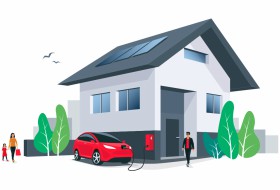Planning Application Guide
Key Information
What are Planning Obligations?
As part of the planning process, a developer may be required to enter into a legal agreement where this is not possible to achieve through planning conditions. These legal agreements are also known as Planning Obligations or Section 106 Agreements and they are secured pursuant to Section 106 of the Town and Country Planning Act 1990 (as amended).
What are they used for?
Planning Obligations can cover almost any relevant issue, acting as a main instrument for placing restrictions on developers, often requiring them to minimise the impact on the local community and to carry out tasks which will provide community benefits, and can include the payment of sums of money.
They are commonly used to bring developments in line with the objectives of sustainable development. Examples of types of infrastructure or services that planning obligations can include are:
- Provision of Affordable Housing
- Specific measures to mitigate impact on a local area – e.g. parking restrictions, habitat protection or management
- Improved community facilities – e.g. Public open space/ play areas, educational facilities
- Highways Improvements
- Restrictions and obligations on the use of land
This list is not exhaustive. Each planning application is dealt with individually on its merits and restrictions and requirements not on this list, may also be needed.
Planning Obligations are usually used in the context of planning applications between the Local Planning Authority (LPA) and persons with an interest in the land (Section 106 Agreement). However, Planning Obligations can also be given unilaterally to the Council by the persons with an interest in the land; these are known as Unilateral Undertakings (UU).
A UU is a commitment offered by the applicant to the LPA with the intention of overcoming any obstacles that may arise which are preventing the granting of a planning permission and to speed up the legal process and determination of planning applications. UUs are drafted by our Legal Department.
Planning Obligations - Supplementary Planning Guidance
Our approach to planning obligations is set out in Policy GP3 ‘Planning Obligations’ of the Carmarthenshire Local Development Plan. Further detail on the implementation of this policy is provided in the Planning Obligations Supplementary Planning Guidance (SPG) as well as in the Affordable Housing SPG, Caeau Mynydd Mawr Special Area of Conservation SPG and the Leisure and Open Space – Requirements for New Developments SPG.
These are available on the Supplementary Planning Guidance webpage.
Monitoring
The Council will monitor planning obligations to ensure that they are complied with in full by the developer and the Council. It should be noted that it is the responsibility of the developer to notify us upon commencement of development and also when any triggers specified in the agreement are reached.
If you agree to provide affordable homes as part of your planning application, it will be formalised as a section 106 agreement. This will state either the percentage of affordable homes you agree to provide (outline applications) or the actual plots and house types (full or reserved matters applications).
The sale prices of these homes will be restricted both at initial sale and at all future sales, based on multiples of the gross median household income in the six community network areas of Carmarthenshire.
These figures are updated in November each year, and are currently:
Planning permission approvals after 1st April 2024
| Community Area | Median household income | 1 bedroom apartment | 2 bedroom apartment/house | 3 bedroom house | 4 bedroom house |
|---|---|---|---|---|---|
| Aman | £35,469 | £90,446 | £123,787 | £147,906 | £175,572 |
| Gwendraeth | £37,109 | £94,628 | £129,510 | £154,745 | £183,690 |
| Llanelli | £33,377 | £85,111 | £116,486 | £139,182 | £165,216 |
| Taf Myrddin | £38,070 | £97,079 | £132,864 | £158,752 | £188,447 |
| Teifi | £34,873 | £88,926 | £121,707 | £145,420 | £172,621 |
| Tywi | £37,923 | £96,704 | £132,351 | £158,139 | £187,719 |
Notes:
1) Based on household incomes data supplied by ward by CACI Paycheck, December 2024
2) Based on 4.17 times median household income for typical 3 bedroom house
3) Multiple of median income 2.55 for 1 bed; 3.49 for 2 bed; 4.95 for 4 bed
Planning permission approved on or before 31st March 2024
| Community Area | Median household income | 1 bedroom apartment | 2 bedroom apartment/house | 3 bedroom house | 4 bedroom house |
|---|---|---|---|---|---|
| Aman | £35,469 | £74,672 | £93,339 | £112,007 | £130,675 |
| Gwendraeth | £37,109 | £78,124 | £97,655 | £117,186 | £136,717 |
| Llanelli | £33,377 | £70,267 | £87,834 | £105,401 | £122,968 |
| Taf Myrddin | £38,070 | £80,147 | £100,184 | £120,221 | £140,258 |
| Teifi | £34,873 | £73,417 | £91,771 | £110,125 | £128,479 |
| Tywi | £37,923 | £79,838 | £99,797 | £119,757 | £139,716 |
Notes:
1) Based on household incomes data supplied by ward by CACI Paycheck, December 2024
2) Based on 3 times median income plus 5% deposit for typical 3 bedroom house
Viability
Should you wish to challenge the viability of your development, you can utilise the Council’s Development Viability Model (DVM) Assessment Tool.
Is there a definition of a non-material amendment?
There is no statutory definition of ‘non-material’. This is because it will be dependent on the context of the overall scheme – an amendment that is non-material in one context may be material in another. We must be satisfied that the amendment sought is non-material in order to grant an application under section 96A of the Town and Country Planning Act 1990.
Can an application to make a non-material amendment be made using the standard application form?
Yes; An application seeking a non-material amendment to a planning permission can be made using the standard application form. Further information about the process of applying for a non-material amendment can be found on the Welsh Government's Website.
Can this procedure be used to make non-material amendments to listed building consents?
No; The procedure cannot be used to make non-material amendments to listed building consents. It only applies to planning permissions
Is consultation/publicity required?
As an application to make a non-material amendment is not an application for planning permission, the existing Town and Country Planning (Development Management Procedure) (Wales) Order 2012 provisions relating to statutory consultation and publicity do not apply. Therefore we have discretion in whether and how we choose to inform other interested parties or seek our views.
Can anyone make a non-material amendment application?
An application can only be made by a person who owns or has a legal interest in the land to which the non-material amendment relates, or someone else acting on their behalf. These are:
- A freeholder
- A holder of a lease with over two years remaining (whether as a head lessee, sub-lessee or tenant of an agricultural holding)
- A mortgagee
- Someone with an estate contract (i.e. an option to acquire a legal interest in the land or a contract to purchase the land)
What is the time period for determination?
The time period for determination is 28 days, or a longer period if that has been agreed in writing between the parties.
What does the local planning authority have to take into account when making its decision?
We must have regard to the effect of the change, together with any previous changes made under section 96A. As an application made under Section 96A of the TCPA 1990 is not an application for planning permission, statutory consultation and publicity do not apply. Therefore local planning authorities have discretion in whether and how they choose to inform other interested parties or seek their views. If the local planning authority considers it necessary to seek the views of an interested party, anyone notified must be told that they have 14 days to make representations from the date of notification, after which their representations may not be taken into account.
What is the procedure for issuing a decision?
The decision must be issued in writing. There is no prescribed form for this.
What should the decision letter cover?
The decision only relates to the non-material amendments sought and the notice of the decision should describe these. It is not a reissue of the original planning permission, which still stands. The two documents should be read together.
What is a variation of planning permission?
Amending the conditions attached to a permission including seeking minor material amendments (application under section 73 of the Town and Country Planning Act 1990)
How are the conditions attached to a planning permission amended?
An application can be made under section 73 of the Town and Country Planning Act 1990 to vary or remove conditions associated with a planning permission. One of the uses of a section 73 application is to seek an amendment to a planning permission, where there is a relevant condition that can be varied.
Are there any restrictions on what section 73 can be used for?
Yes, the variation must not be substantially different from the original planning permission.
What is the effect of a grant of permission?
Where an application under section 73 is granted, the effect is the issue of a new planning permission, sitting alongside the original permission, which remains intact and unamended.
A decision notice describing the new permission should be issued, setting out all of the conditions related to it. To assist with clarity decision notices for the grant of planning permission under section 73 should also repeat the relevant conditions from the original planning permission, unless they have already been discharged.
If the original permission was subject to a planning obligation then this may need to be the subject of a deed of variation.
Do the Environmental Impact Assessment Regulations apply?
A section 73 application is considered to be a new application for planning permission under the 2017 Environmental Impact Assessment Regulations. Where the development is listed under either schedule 1 or schedule 2 to the Regulations, and satisfies the criteria or thresholds set, we must carry out a new screening exercise and issue a screening opinion whether an Environmental Impact Assessment is necessary.
Where an Environmental Impact Assessment was carried out on the original application, we will need to consider if further information needs to be added to the original Environmental Statement to satisfy the requirements of the Regulations. Whether changes to the original Environmental Statement are required or not, an Environmental Statement must be submitted with a section 73 application for development which we will considers to be an Environmental Impact Assessment development.
Can section 73 be used to make a variation of planning permission if there is no relevant condition in the permission listing approved plans?
Section 73 cannot be used for a variation of planning permissions if there is no relevant condition in the permission listing the originally approved plans.
It is possible to seek the addition of a condition listing plans using an application under section 96A of the Town and Country Planning Act 1990. This would then enable the use of a section 73 application to make a variation of planning permissions.
Information on how to vary planning conditions can be found here.
The primary function of the Building Control service is to protect people’s health and safety in the built environment.
Building Regulations are national standards for Wales which apply to most types of buildings, whether in the home or a commercial development. They ensure that the environment in which we all live is a safe and healthy place. They also ensure that adequate access and facilities are provided for people with disabilities and include requirements for conservation of fuel and power.
Building control surveyors administer building regulations. We are a highly qualified and experienced team of building control surveyors who examine and comment on plans for most building work and inspect the work that is in progress. Our wide knowledge of materials and building methods are available to you at all stages of the building process.
For more information on Building Control & Building Regulations, please visit out webpages.
About Local Authority Building Control (LABC)
Local Authority Building Control (LABC) represents all local authority building control teams in England and Wales. Here's is a summery of who they are and what they do:
- LABC teams are independent, impartial and not for profit. Public service building control is committed to safeguarding the safety and protection of our communities by constantly reviewing surveyor competence and ensuring the performance and standards of our teams.
- We believe all new buildings, conversions and extensions can be delivered to the right standards by coordinating the design, specification, construction and completion phases. The surveyors in our local councils care about the long-term safety, inclusivity and performance of buildings in your communities.
- LABC network of around 3,800 professional surveyors will provide you with fast, impartial, expert advice.
- Whether you're a home or property owner, architect, plan drawer, developer, building contractor or another professional, they will work with you to ensure your buildings are safe, healthy, inclusive and efficient, and meet the standards set by the Building Regulations.
- They also advise on public safety, consumer protection, safety at sports grounds, dangerous structures and they routinely work with the emergency services and other functions such as HSE, Trading Standards and Environmental Health to deliver safe buildings.
Traditional surface water drainage systems can increase the risk of flooding & pose a serious risk of contamination. Sustainable Drainage Systems (SuDS) have been developed to imitate the natural drainage process & eliminate these risks.
SuDS can be used effectively in both rural and urban areas to support new development and redevelopment, whilst reducing the risk of surface water flooding & creating opportunities for improved water quality, bio-diverse rich habitats & new community recreational spaces.
The Highways Design Guide was produced with a view to setting out its expectations for new development in the county. It provides guidance to developers and applicants on preparing transport proposals and providing transport infrastructure and services to support new development. It also sets out the associated requirements during planning and construction.
See our Highways Planning Liaison page for further information.
What are planning conditions?
Planning conditions are often applied to the grant of planning permission. These limit and control the way in which the planning permission must be implemented. Aiming to improve the quality of planning applications through the mitigation of any adverse effects.
Conditions may be imposed on the grant of planning permission for regulating development or use of any land. Limiting works on the land to ensure the development can be approved through meeting specified requirements set out by us. For example, these may specify the nature of the building work, hours of opening, length of time permission is granted for or the necessary assessments which accompany an application. The conditions applied by us should be kept to a minimum.
Pre-application discussions between ourselves and the applicant can help reduce the need for planning conditions to be placed on an application.
Who should apply for approval (discharge) of conditions?
If you have conditions on your planning permission that require our approval before development can start, you can apply to have conditions discharged (approved) so that your development can begin. You will be required to detail how you intend to meet the requirements of the conditions (e.g. the materials you will use) or provide supporting information to demonstrate compliance. This will allow us to approve the conditions (this is also known as ‘discharging conditions’). A single application can cover any number of conditions from the permission. You will need to formally submit the information and complete an application form with the relevant fee.
A separate application type is available for the removal or variation of conditions, this should be used if you believe the conditions are no longer applicable or would be more effective in a modified state.
Upon receipt of an application to discharge conditions, the case officer will assess the submission and consult with relevant consultees as necessary. If the information is considered acceptable, a formal decision notice will be issued confirming that the condition is either fully or partially discharged. If the information is not acceptable, the discharge of condition application can be refused. Please ensure that you keep a record of any decisions issued.
Refused Applications:
If you receive a decision notice that has refused permission, the full reasons will be stated on the decision notice. You will need to carefully read those reasons and consider whether you wish to try and resolve them through the amending your proposal and resubmitting an application. If you wish to have discussions with the Case officer, you are encouraged to utilise our pre-application service.





